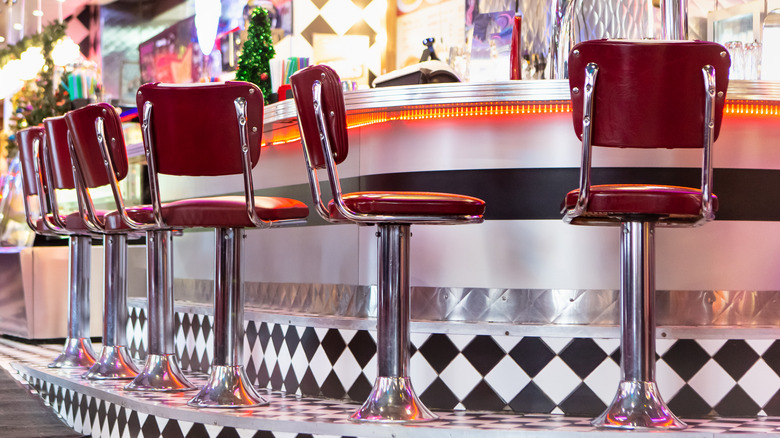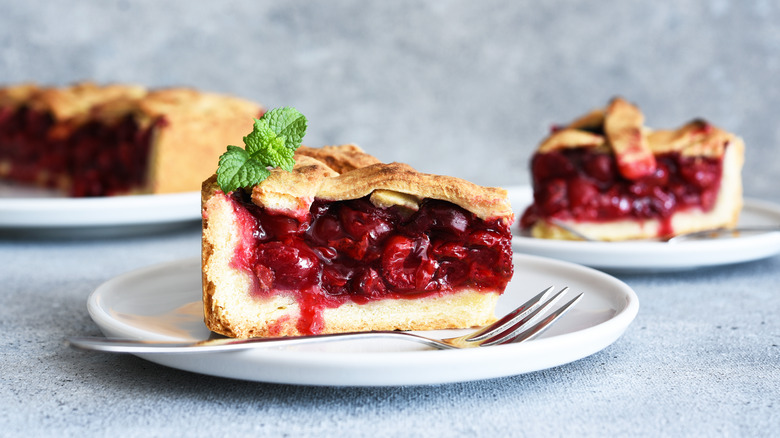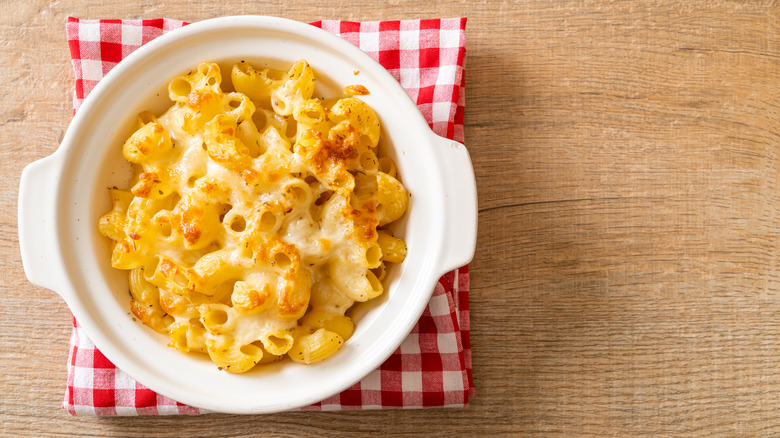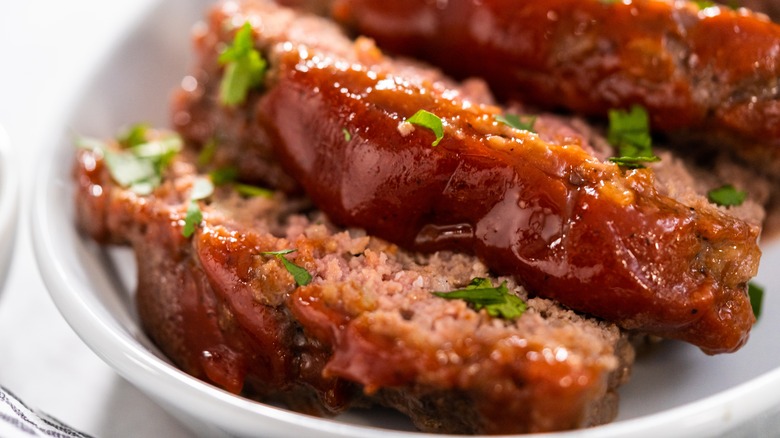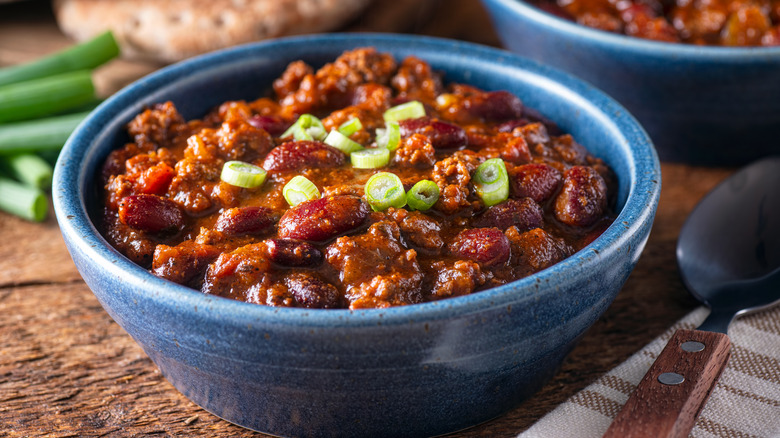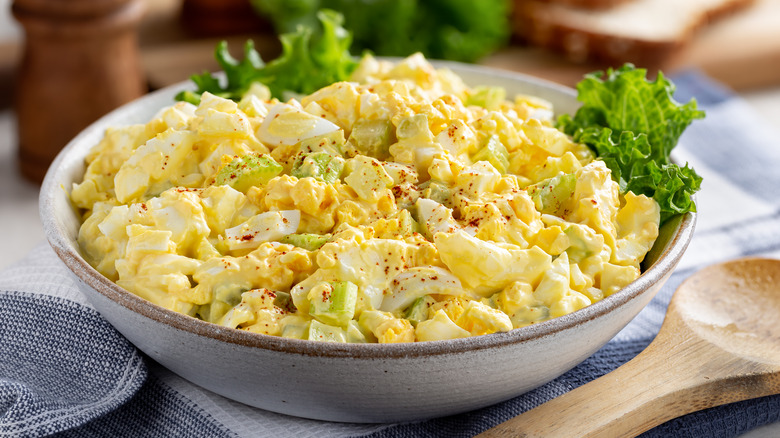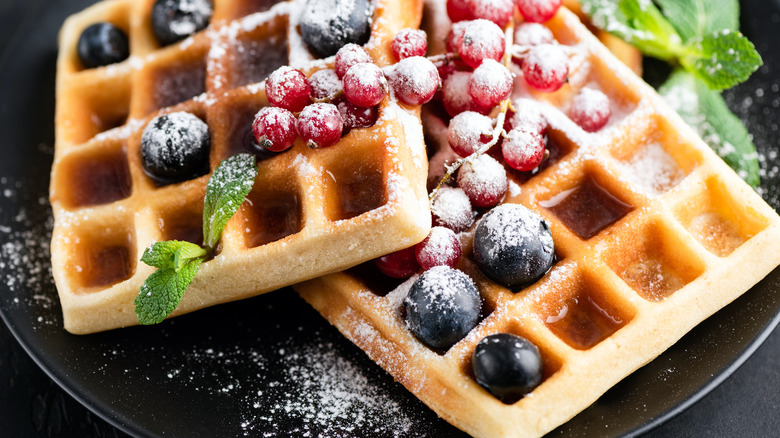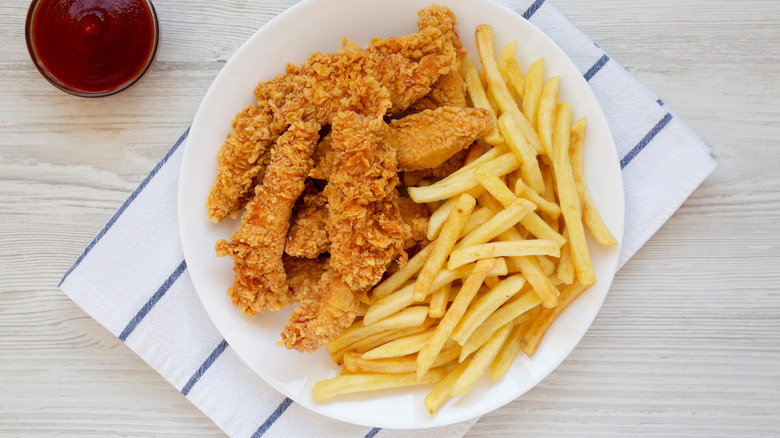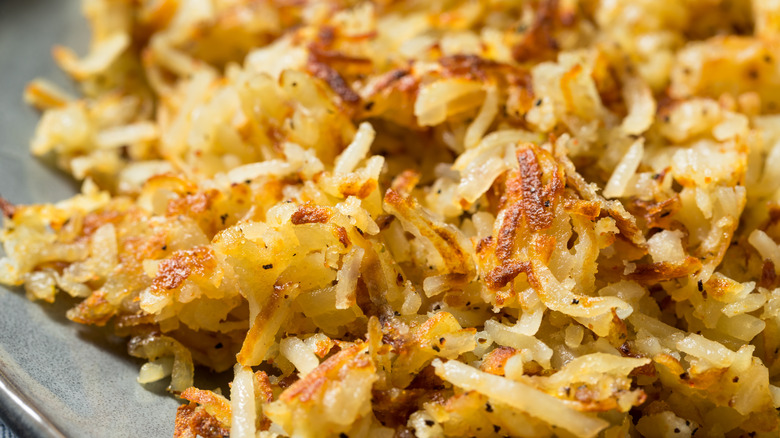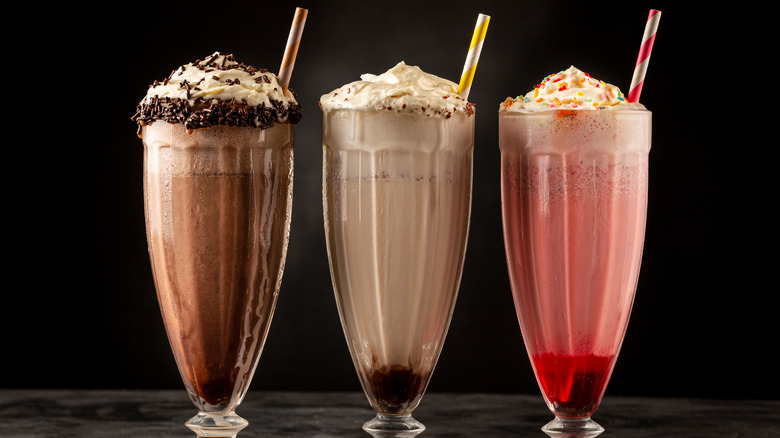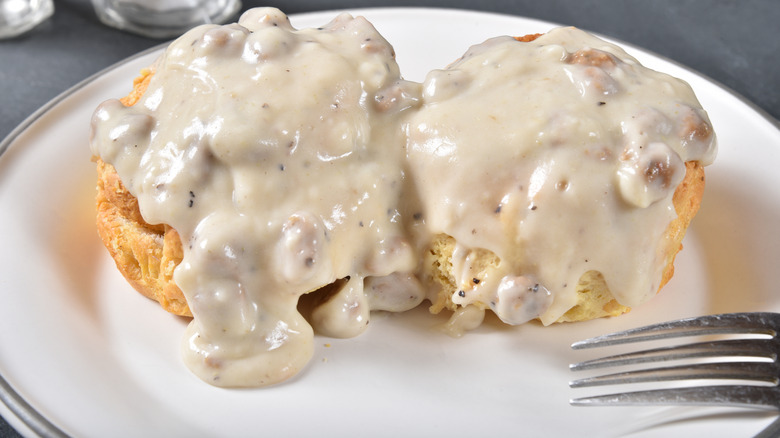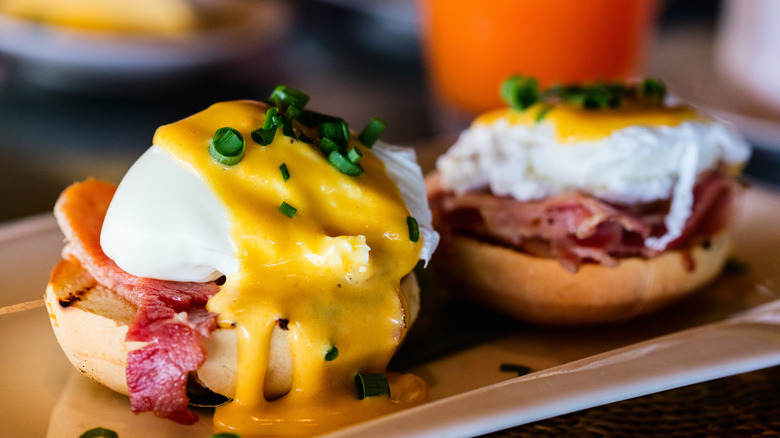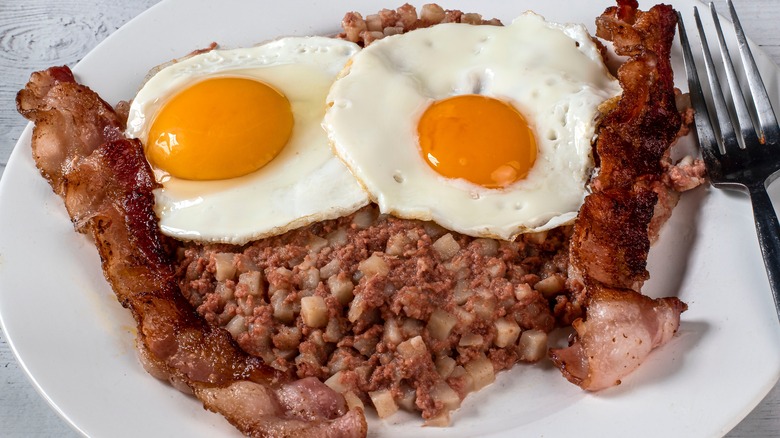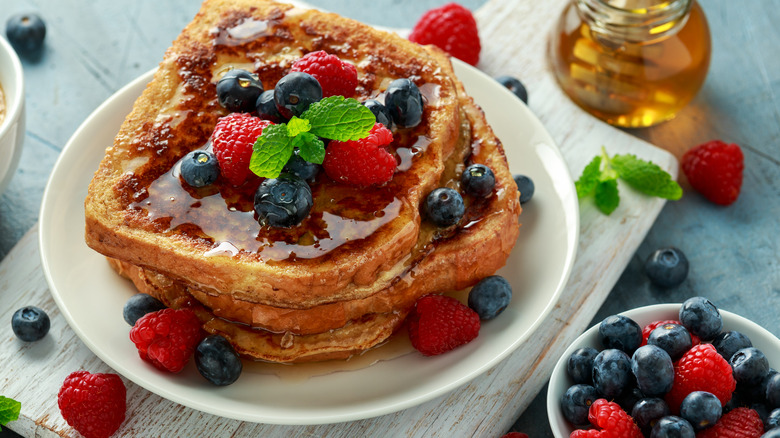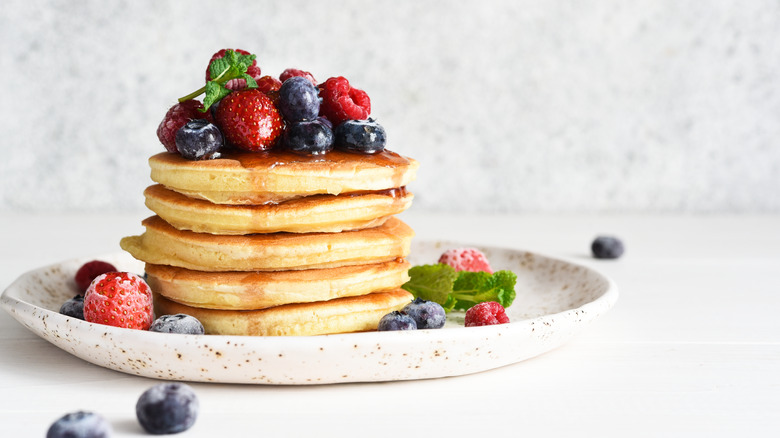14 Foods That Always Taste Better In A Diner Than What You Make At Home
You may picture a nostalgic scene from the 1950s — women in cheery printed dresses full of crinoline, and men in trousers and fedora hats, seated on red bar stools when you hear the word "diner." The diner seems to coincide with that decade. Although the history of diners begins long before the 1950s, it's that time of poodle skirts and soda jerks that made the diner an American icon.
Thankfully, diners still thrive today. It seems Americans just can't get enough of vinyl booths and ultimate comfort food. From meatloaf that reminds us of our childhood to glass cases full of berry, cream, and apple pies, the diner is a staple throughout the country, and you can still count on stopping at plenty of them on your next long road trip.
As great as the love affair with the diner is, there is one thing that's tough to replicate at home — the food. Just as you wouldn't even attempt to replicate that perfect beef filet at your favorite steakhouse, certain foods are better off eating at your favorite diner rather than making them at home. Follow along as we look at which foods are simply yummier in the diner.
All kinds of pie
What's your favorite type of pie? If you can't choose, that's okay. Head on over to your local diner. More than likely, they have a multitude of choices, from cherry, French silk, triple berry, and all-American apple. Certainly, grandma's pie is something you look forward to every time you visit and it's probably incredible. Still, there's something about pulling into a diner at the end of a long drive and indulging in a piece of warmed pie with a dollop of ice cream that just can't be replicated, even by grandma.
Maybe it's the flaky crust, the perfectly stacked fruit inside, or the fancy spinning glass case that houses all the diner desserts that makes diner pie impossible to replicate at home. Whatever it is, please keep it coming. According to Crisco® and The American Pie Council, 92% of Americans love pie, enough to keep diners busy with plenty of pie.
Mac & cheese
Ooey, gooey, cheesy, delicious macaroni and cheese or as many of us lovingly refer to it as mac & cheese, isn't just for little kids. It comes in many forms: Italian mac & cheese, crockpot mac & cheese, mac & cheese from a box, and the ultimate, diner-style mac & cheese.
Although macaroni and cheese aren't only for kids, one of the reasons many adults seek comfort in the cheesy pasta is because it reminds them of mom. Shira Gabriel, a professor at the University of Buffalo, told the Washington Post, "You don't think 'I'm having mac and cheese today because I'm feeling lonely and I need my mom,'" said Gabriel. "But that's actually part of what's happening." Whatever the reason, scout out a nearby diner when you get a hunkering. It'll likely be served with enough melted cheese to hold a small building together, and of course, expect a mound of buttery breadcrumbs on top of the cheesy noodles because, after all, the calories from pasta and cheese aren't enough.
Meatloaf
Is there a greater comfort food than meatloaf? Doubtful. There's some division on this one. You've got people who turn their noses up at the word "meatloaf" and others who order it off every menu they can. Truth be told, the word meatloaf isn't exactly appetizing (a loaf of meat?). Still, moms and the American diner made meatloaf famous, and you'll still find it on the menu today. And it's not just in nostalgic diners. Meatloaf has been elevated and even shares menus with gourmet items, such as foie gras. Texas chef Gavin McMichael tells NBC News, "I was a huge fan, so, of course, I had to have meatloaf on my dinner menu," said McMichael, a partner in the Blacksmith restaurant in one of the fastest-growing sections of Oregon.
Many of us grew up with meatloaf, and if you're now raising a family of your own, you get it — a pan full of ground beef is an economical choice. Plenty of people have a meatloaf family recipe handed down for generations, often created during the Great Depression when money was tight. If you are sadly nowhere near a diner, try our classic meatloaf recipe to satisfy the craving. If you are near a diner or planning a road trip where you can experience several along the way, you've got to order meatloaf. Classic diner-style meatloaf is made with ground beef and often includes yummy ingredients such as Worcester sauce, ketchup, or BBQ sauce, and a handful of crackers or oatmeal to bind it all together. Every recipe varies, and most diners won't divulge their secret ingredients, so good luck recreating it at home.
Chili
Every family has their chili recipe, but nothing compares to a steaming cup of chili comfort at a diner, preferably on a cold, rainy day. Chili is a fascinating food since it has more variations than one can count and is eaten in several cultures. Did you know that chili is the official dish of the state of Texas? There may be plenty more to chili than you know. For one, it's not from Mexico, and rumor has it that chili may have been invented by a mysterious nun from Spain who had the chilling ability to be in more than one place at a time. We won't question it; just don't take away the chili.
No matter where it came from, Americans love the stuff. We have chili potlucks, chili cook-offs, and even pour the spicy concoction on top of hot dogs with no feelings of shame. There are meatless, meat-only, mild, spicy, and flaming hot recipes. At a diner, you'll likely find a classic full of both beans and meat, served in a white cup with a saucer, and always, a package with two Saltine crackers for dipping or crumbling up into the dish. Simplicity at its best.
Egg salad
With or without bread, egg salad is the picnic classic that excels at diners. Our egg salad recipe calls for just four ingredients plus the eggs, but most people add their own little twist. At a diner, you may find onions or celery in the egg salad, and always the option for classic white bread toasted or not toasted.
While the origin of egg salad is often debated, according to The Encyclopedia of Sandwiches, one origin story sources the first egg salad recipe to the 1896 edition of The Boston Cooking-School Cook Book. Likely it was being prepared long before it entered a cookbook, as egg salad has probably been around at least as long as diners have. When making your own, check out these helpful hints about boiling eggs so they cook properly and peeling isn't a nightmare.
Here's the great thing about egg salad at a diner: it's one of the healthiest options on the menu. Diners aren't exactly where the health-conscious are flocking to, and that's okay. We need our diners to serve up that comfort food we love. However, if you're watching the waistline, egg salad isn't a bad choice when dining at the diner.
Waffles
Today, the waffle has expanded its repertoire, sporting much more than syrup. Although, even the waffle itself must admit, its gridded texture was destined to become syrup filled. There are 16 different types of waffles, most stemming from different cultures and their take on the warm, golden-brown dish.
So, why are waffles like the ones at the famous roadside diner, "Waffle House," so much better than making them at home? One thing that makes Waffle House waffles so delicious is the secret ingredient (not so secret anymore) of half and half. It just makes sense, right? Half and half is an easy milk replacement, but it's so much creamier. Also, after years of experimenting, diners have figured out the perfect size squares for holding the syrup — they can't be too big or too small. Aren't you kind of eager to have a waffle right now?
As mentioned, waffles are now donning a lot more than syrup, namely, fried chicken. What genius came up with that idea? They are also still enjoyed with fruit, powdered sugar, and even a little whip cream now and then.
Chicken tenders
Chicken tenders used to be considered a kids' menu item until they started sneaking onto the main menu at many restaurants. Looks like parents figured out that the kids were on to something. You can't beat the perfectly fried, crispy goodness of a mound of chicken tenders with a side of fries on a diner's plate. Diners are known for good-sized portions; thankfully, they're also known for having doggie bags to bring home the leftovers. Chicken tenders make a great second meal when reheated; just make sure you aren't heating your chicken tenders the wrong way. Keep them out of the microwave, so they don't go from crispy to soggy.
Just like with many greasy, comfort foods, making the perfect chicken tenders at home seems impossible. There's a good reason for this, and it's not your amateur chef skills. In a diner, they control the temperature of the oil perfectly, and the quick fry that makes the breading so crunchy also keeps the chicken juicy and tender. Try as you may at home when frying things; it's really hard to get the oil to the right temperature and time everything perfectly. Some people oven-bake chicken tenders, and that's a healthy option, but it won't have the same snap as a crispy tender at a diner.
Hashbrowns
How do you prefer your hashbrowns? Chewy, crispy, or burnt to a crisp? And have you ever noticed you crave those salty potatoes after a long night of, shall we say, indulging? There's a good reason for that. Queensland Health explains that alcohol is a diuretic, which causes us to use the restroom more often. All of that expelling of fluids from your system dehydrates your body. And guess what you crave when dehydrated? Salt. So, it's perfectly normal that you can't get enough of the stuff after some drinking. No wonder diners are full of recuperating people on a Saturday morning when the sun is just about to come up.
Hashbrowns come in many forms: shredded, chopped, sliced, or diced. You may find some with onions and peppers, always salt and pepper, and sometimes even some melted cheese. The classic diner hashbrown is shredded potatoes, pan-fried in oil or butter until golden or dark brown, then served, usually as a helping large enough to feed an entire table, even if it's just your plate, alongside some eggs. Whether it's for breakfast, lunch, dinner, or a late-night snack, Americans love their diner-style hashbrowns.
Milkshakes
This is a tough one to accept. Why can't your milkshake at home get the same consistency as the one at the diner? There are a few tips to make a great milkshake at home for a delicious treat, such as adding a little cake mix or using your food processor to mix it all up; however, there's nothing like having the perfect diner shake brought to your table. No work for you, and the creamiest consistency and flavor every time.
Can you imagine a world without milkshakes? It's horrid to consider. Unfortunately, that used to be the case. According to Hamilton Beach Commercial, the first time the word "milkshake" was seen in print was back in 1885, and it referred to a drink for adults only. Sorry kids. The first milkshakes were a concoction of whiskey and eggs. At some point in the early 1900s, the milkshake made with ice cream and flavored syrups became popular and still tempts ice cream lovers today.
Biscuits and gravy
Biscuits and gravy is southern comfort food at its finest, and you can almost get full by saying "biscuits and gravy." Many of us have that one friend, or maybe it's you, who talks about grandma's biscuits and gravy. Age-old family recipes get passed down, and the tradition of sausage bathing in white gravy and swimming on top of homemade buttermilk biscuits is one of the tastiest.
Biscuits and gravy have a hard-working history, as they originated in the southern Appalachians around the late 1800s. Likely, the origination is correct since you'll also hear biscuits and gravy called sawmill gravy, and the Appalachia area was a lumber industry during that time, per The Columbian. Wherever it stems from and whoever so lovingly continues the legacy, biscuits and gravy was destined to become diner food.
Today, you can find new takes on the old favorite, including jalapeño biscuits and gravy, which goes beyond the basic white gravy and adds some chorizo to it, along with jalapeños in the biscuit. Change is fun, and it's always good to try new things; still, when you need a reminder of grandma or just some comforting food, your favorite diner promises classic biscuits and gravy on the menu.
Eggs benedict
There's something sophisticated about eggs benedict, yet the old-fashioned classic diner makes it best. As legends go, we are told that the lovely eggs benedict may result from a hungover fellow. Hot Box London writes that in 1894 at the Waldorf Hotel in New York, a man named Lemuel Benedict, who was a bit under the weather after an evening of painting the town red, ordered two poached eggs on top of buttered toast with bacon and hollandaise sauce from the hotel kitchen. The chef loved it, and eggs benedict was born. Way to go, Lemuel.
You can certainly try your hand at eggs benedict at home with our easy recipe if you aren't fortunate enough to be near a diner. Many restaurants now offer eggs benedict as well, and it comes in all kinds of non-traditional forms, including the addition of tomatoes or asparagus, Florentine style with spinach, artichokes, and anchovies, and even Eggs Neptune, which switches out traditional meats like ham or bacon for crabmeat. As always, it's the classic diner version that stands the test of time with poached eggs, Canadian bacon, and hollandaise sauce.
Corned beef hash
Remember when mom used to dump Hormel corned beef hash out of a can and call it dinner? Now that you're grown up, you understand — corned beef hash was and still is fast and inexpensive. At a diner, you won't find it canned, though. A hash dish can be any chopped meat mixed with potatoes, but corned beef hash is the most common. Homemade corned beef and hash is a little bit different than the canned version. It includes corned beef and potatoes, salt and pepper, onions, butter, chives, and parsley, and a great way to use up the leftovers from a corned beef dinner.
The Original Pancake House in Denver writes that corned beef became popular in America when Irish immigrants used it as a substitute for bacon. Today, it's used in hash along with a side of eggs at breakfast time, and it's a diner specialty, often served as a warm skillet.
French toast
Crispy on the outside and warm and welcoming on the inside, French toast is simple, decadent, and seducing everyone as they read the diner menu. Imagine, if you will, a dish with milk and eggs and a piece of white bread. That's it. That's all it takes, and you've got a soft, chewy, sweet breakfast. That's what makes French toast so wonderful and why diners serve it like crazy, both day and night.
Did you know that you can even make French toast in a crockpot at home? How fabulous is that? It soaks overnight and then cooks on low for four hours, all in one slow-cooking dish. How do you prefer your French toast? At a diner, it's lovingly sprinkled with powdered sugar, then served with plenty of butter, usually in the shape of a scoop of ice cream and a side of warm syrup.
Not to shatter anyone's illusions as they eat French toast, but it isn't exactly French. According to Frenchly, French toast dates way back to the Romans in a recipe book from the 5th century. Named Pan Dulcis, it called for dipping bread into milk and eggs and frying it. However, it is popular in France, and they call it pain perdu, meaning lost bread, because, in the early days, it was a way to make use of stale bread. If you like, the next time you are serving French toast to friends and family, tell them you're making pain perdu, and they'll be impressed.
Pancakes
There are a few reasons why pancakes taste better at a diner than at home. For starters, these cooks are absolute experts when it comes to making breakfast. They whip up more pancakes in a day than most of us will make all year round, getting really good at techniques like not overmixing the batter. Mixing any flour-based product leads to gluten development, which is fantastic for breads and pizza doughs. Overmixed pancake batter loses its fluffy texture and becomes dense and chewy instead. Of course, you can practice this technique and learn how to tell when your pancake batter is over or under-mixed, or you can leave it to the experts.
It also comes down to equipment. You may have a cast-iron or electric griddle at home, but it's probably nowhere near as large as the flat top grill used at most diners. Imagine if your stovetop didn't have individual burners and featured a single smooth surface instead. This creates an evenly heated workspace that cooks pancakes to perfection, and it also gives the cooks plenty of room to make multiple products at once. Most of us only have room to cook one or two pancakes at a time, so we have to find a way to keep them warm while the rest finish cooking. That can lead to soggy pancakes, but a diner can produce the whole stack in one go. Unless you're ready to invest in a flat-top grill, you'll never be able to match that pace.
